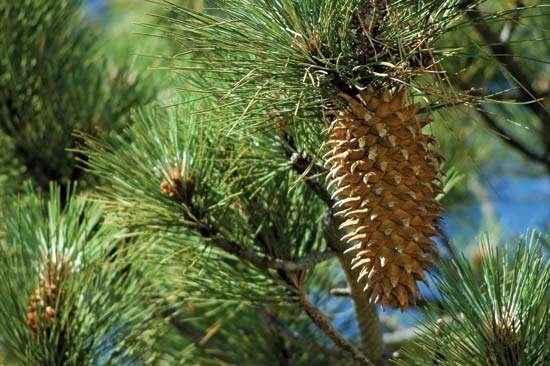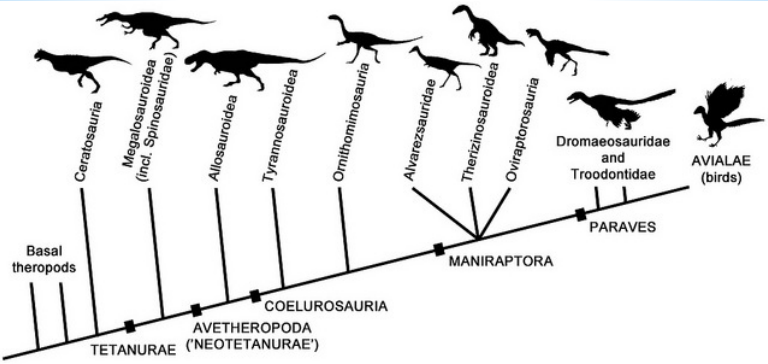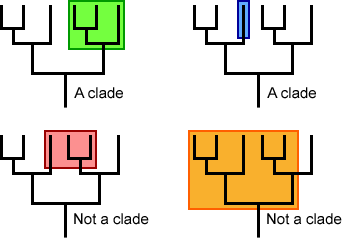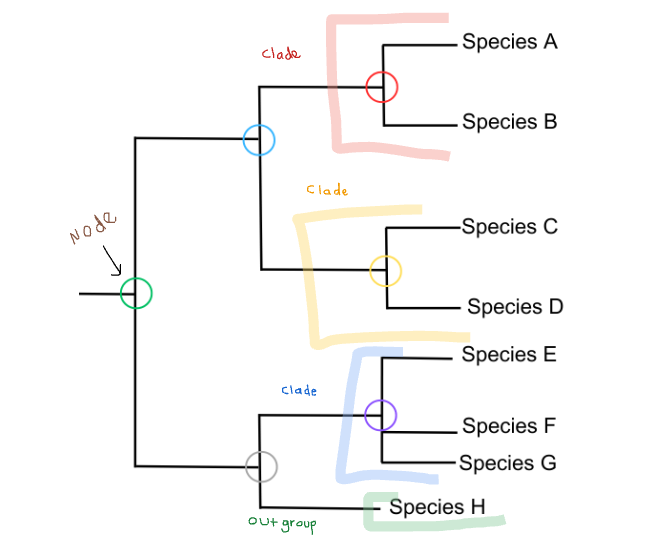
BIO Unit 5 notes
multiple choice
short answer
extended answer
four plant phyla and their characteristics
how to classify an organism of choice from domain to species
create a dichotomous key using animal classes and their phylum
Phylum: Chordata
Characteristics:
Notochord (vertebrate) present at some stage
Dorsal nerve cord
Examples:
Mammals: Cats
Birds: Eagles
Fish: Sharks
Reptiles: Snakes
Amphibians: Frogs
interpret one cladogram to see what organisms are more closely related to one another
The vocabulary’
Dichotomous Key for Chordata
Phylum: Chordata
Characteristics:
Notochord (vertebrate) present at some stage
Dorsal nerve cord
Examples:
Mammals: Cats
Birds: Eagles
Fish: Sharks
Reptiles: Snakes
Amphibians: Frogs
Does the animal have legs?
Yes, go to 2
No, go to 6
Does the animal have four legs?
Yes, go to 3
No go to 5
Does the animal have fur?
Yes, it’s a cat
No go to 4
Does the animal live both in water and on land, and have smooth skin?
Yes, it’s a frog
No, it’s another amphibian
Does the animal have feathers and fly?
Yes, it’s an eagle
No, it’s another bird
Does the animal live in water and have fins?
Yes, go to 7
No, go to 8
Is the animal a carnivorous apex predator in the water?
Yes, it’s a shark
No, it’s another fish
Does the animal have scales and a long, limbless body?
Yes, it’s a snake
No, it’s another reptile
Four Plant Phyla and Their Characteristics
1. Bryophyta (Mosses)
Characteristics:
Non-vascular plants
Require moist environments
Reproduce via spores
Lack true roots, stems, leaves, seeds, and flowers
Examples:
Sphagnum moss
Liverworts
2. Filicinophyta (Ferns)
Characteristics:
Vascular plants
Have true roots, stems, and leaves
Reproduce via spores
Prefer shaded, moist environments
They don’t have seeds or flowers
Examples:
Boston fern
Maidenhair fern
3. Coniferophyta (Pine trees/Conifers)
Characteristics:
Vascular plants with roots, stems, leaves, and seeds
They don’t have flowers
Seeds are not enclosed in an ovary (naked seeds, pine cones)
Often produce cones (strobili)
Adapted to a variety of environments
Examples:
Pine trees
Cycads

4. Angiospermophyta (Angiosperms)
Characteristics:
Vascular plants with roots, stems, leaves, and seeds
Produce flowers for reproduction
Highly diverse in form and habitat
Can be monocots or dicots
Examples:
Flowers, roses (dicots)
Grasses (monocots)
Characteristics
Notochord present at some stage
Dorsal nerve cord
Examples
Mammals
Birds
Fish
Reptiles
Amphibians
Understanding animal phylums helps in studying biodiversity and evolutionary relationships.
Classifying a Human from Domain to Species
1. Domain
Eukarya
Organisms with complex cells containing a nucleus.
2. Kingdom
Animalia
Multicellular, heterotrophic organisms that can move and respond to their environment.
3. Phylum
Chordata
Animals with a notochord (vertebrate) at some stage of their development, dorsal nerve cord, and pharyngeal slits.
4. Class
Mammalia
Warm-blooded vertebrates with hair or fur and mammary glands.
5. Order
Primates
Mammals with large brains, forward-facing eyes, and flexible limbs.
6. Family
Hominidae
Great apes and their ancestors, characterized by larger brains and social behavior.
7. Genus
Homo
Genus that includes modern humans and closely related species.
8. Species
Homo sapiens
The species name for modern humans, characterized by advanced cognitive abilities and language.
Domain | Dancing |
Kingdom | Katy |
Phylum | Parry |
Class | Comes |
Order | Over |
Family | For |
Genus | Grape |
Species | Soda |
Taxonomy Importance
Understanding evolutionary relationships.
Organizing biological diversity.
Scientific Classification
Binomial nomenclature (Genus species).
Hierarchical structure for easy identification.
Unit 5 vocab
1. 5.1
Variation: differences in the genetics of organisms of the same species.
Selection pressure: varying survival or reproductive ability of different organisms in a breeding population due to the influence of the environment.
Evolution: the cumulative change of heritable characteristics of a population.
Artificial selection: The breeding of plants and animals to produce desirable traits.
Homologous structures: similar structures due to common ancestry.
Pentadactyl limb: having limbs that end in five digits
Continuous variation: variation in a species which is controlled by several genes producing features that cannot be divided into discrete categories (ex: human height).
Adaptive radiation: the diversification of a group of organisms into forms filling different ecological niches.
Vestigial structure: A structure in an organism that has lost all or most of its original function in the course of evolution, such as human appendixes.
Species: a group of individuals of common ancestry that closely resemble each other and are normally capable of interbreeding to produce fertile offspring.
2. 5.2
Natural selection: a process resulting in the survival of those individuals from a population of animals or plants that are best adapted to the prevailing environmental conditions. The survivors tend to produce more offspring than those less well adapted, so that the characteristics of the population change over time, thus accounting for the process of evolution.
Industrial melanism: darkness acquired by a population of animals living in an industrial region where the environment is soot-darkened.
Antibiotic resistance: The ability of bacteria and other microorganisms to resist the effects of an antibiotic to which they were once sensitive.
MRSA: Methicillin-resistant Staphylococcus aureus, a strain of antibiotic-resistant bacteria.
Genotype: The allele combination of an organism
Phenotype: The characteristics of an organism (determined by a combination of genotype and environmental factors)
Variation: The range of phenotypes of a population
Adaptation: characteristics that make an individual suited to its environment and way of life.
Antibiotics: drugs that inhibit, kill or stop the growth of bacteria.
3. 5.3
Classification: system of arranging species into categories based on physical and evolutionary relationships.
Taxonomy: the science of classification.
Binomial Nomenclature: the two-part name that gives the genus and species of an organism in Latin - for example, Homo sapiens.
Genus: a sub-category of Family in the system of classification.
Species: a sub-category of Genus in the system of classification.
Thermophilic bacteria: Bacteria that inhabit hot sulfur spring and hydrothermal vents and survive in temperatures in excess of 70 degrees Celsius.
Halophilic bacteria: Bacteria that live in very salty environments, such as the Dead Sea or salt mines.
Methanogenic bacteria: Bacteria that live in the digestive system, or in marshlands or landfills. They produce methane as a waste product of cell respiration.
Archaea: A Domain of life consisting of the oldest, most “extreme”, bacterial organisms. (Ex: thermophilic bacteria, halophilic, methanogenic).
Eubacteria: A Domain of life consisting of newer forms of bacteria commonly seen today. (Ex: E. Coli or MRSA).
Eukarya: A Domain of life consisting of more complex organisms seen today. (Ex: Plants, animals).
Dichotomous key: A key in which organisms are separated into pairs of smaller and smaller groups by observation of their characteristics.
4. 5.4
DNA: (deoxyribonucleic acid) the fundamental heritable material, contained in the nucleus in eukaryotes.
Amino Acids: one of the building blocks of protein, which make up all parts of the body.
Cladogram: diagrammatic representation of cladistic relationships.
Clade: all the organisms both living and fossil descended from a particular common ancestor.
Cladistics: a way of classifying organisms which uses lines of descent rather than physical similarities.
Phylogenetics: a classification system based on evolutionary relationships.
Analogous characteristics: structures with similar functions but which have different evolutionary origins.
Cladograms
Key Terms
Clade: a branch that includes a single common ancestor and all of its descendants
Node: points in the cladogram where there are divergences or speciation events.
Outgroup: an organism that is distantly related to the rest of the organisms on the cladogram.
The sharks are the least related to the mammals in both cladograms. From the cladogram on top you can see they are the least related to the mammals due to the distance between them, the mammals are at the beginning of the cladogram while the shark is at the other end of the cladogram. This makes the sharks an outgroup, as it’s an organism that is distantly related to the rest of the organisms on the cladogram. On the one below you can tell once again the sharks and mammals are placed on opposite ends and don’t share a clade. You can tell the most closely related are the birds as they diverged first, then the reptiles that diverged from them and then the amphibians, finally the sharks.

1. Did the Allosaurus group diverge before or after the tyrannosaurs?
They diverged after the tyrannosaurs group because they are farther along the line and come after the tyrannosaurs.
2. Are the Oviraptors more closely related to the birds than the Tyrannosaurus are? How can you tell?
The oviraptors are more closely related to the birds than the tyrannosaurus group because they are closer to the bird on the cladogram than the tyrannosaurus.

1. A clade shows the last common ancestor and all the descendant branches. Which of the boxes 1,2 or 3 Does not show a clade? Explain why.
Box three does not show a clade because it cut off one of the diverged branches, the Hedylidae which should have been included in the box to make it a clade.
2. Why are there different interpretations of the data used to make a cladogram?
Since every person interprets data differently, the results of the data may differ from person to person, so the cladograms made may be different depending on the interpretation of the data.
The three components of the cladogram in the image are nodes, clades, and branches. The nodes are the points in the picture where the Branches diverge. The clades are the common ancestors, and the branches are the lines that connect the species in the cladogram to the nodes.


BIO Unit 5 notes
multiple choice
short answer
extended answer
four plant phyla and their characteristics
how to classify an organism of choice from domain to species
create a dichotomous key using animal classes and their phylum
Phylum: Chordata
Characteristics:
Notochord (vertebrate) present at some stage
Dorsal nerve cord
Examples:
Mammals: Cats
Birds: Eagles
Fish: Sharks
Reptiles: Snakes
Amphibians: Frogs
interpret one cladogram to see what organisms are more closely related to one another
The vocabulary’
Dichotomous Key for Chordata
Phylum: Chordata
Characteristics:
Notochord (vertebrate) present at some stage
Dorsal nerve cord
Examples:
Mammals: Cats
Birds: Eagles
Fish: Sharks
Reptiles: Snakes
Amphibians: Frogs
Does the animal have legs?
Yes, go to 2
No, go to 6
Does the animal have four legs?
Yes, go to 3
No go to 5
Does the animal have fur?
Yes, it’s a cat
No go to 4
Does the animal live both in water and on land, and have smooth skin?
Yes, it’s a frog
No, it’s another amphibian
Does the animal have feathers and fly?
Yes, it’s an eagle
No, it’s another bird
Does the animal live in water and have fins?
Yes, go to 7
No, go to 8
Is the animal a carnivorous apex predator in the water?
Yes, it’s a shark
No, it’s another fish
Does the animal have scales and a long, limbless body?
Yes, it’s a snake
No, it’s another reptile
Four Plant Phyla and Their Characteristics
1. Bryophyta (Mosses)
Characteristics:
Non-vascular plants
Require moist environments
Reproduce via spores
Lack true roots, stems, leaves, seeds, and flowers
Examples:
Sphagnum moss
Liverworts
2. Filicinophyta (Ferns)
Characteristics:
Vascular plants
Have true roots, stems, and leaves
Reproduce via spores
Prefer shaded, moist environments
They don’t have seeds or flowers
Examples:
Boston fern
Maidenhair fern
3. Coniferophyta (Pine trees/Conifers)
Characteristics:
Vascular plants with roots, stems, leaves, and seeds
They don’t have flowers
Seeds are not enclosed in an ovary (naked seeds, pine cones)
Often produce cones (strobili)
Adapted to a variety of environments
Examples:
Pine trees
Cycads

4. Angiospermophyta (Angiosperms)
Characteristics:
Vascular plants with roots, stems, leaves, and seeds
Produce flowers for reproduction
Highly diverse in form and habitat
Can be monocots or dicots
Examples:
Flowers, roses (dicots)
Grasses (monocots)
Characteristics
Notochord present at some stage
Dorsal nerve cord
Examples
Mammals
Birds
Fish
Reptiles
Amphibians
Understanding animal phylums helps in studying biodiversity and evolutionary relationships.
Classifying a Human from Domain to Species
1. Domain
Eukarya
Organisms with complex cells containing a nucleus.
2. Kingdom
Animalia
Multicellular, heterotrophic organisms that can move and respond to their environment.
3. Phylum
Chordata
Animals with a notochord (vertebrate) at some stage of their development, dorsal nerve cord, and pharyngeal slits.
4. Class
Mammalia
Warm-blooded vertebrates with hair or fur and mammary glands.
5. Order
Primates
Mammals with large brains, forward-facing eyes, and flexible limbs.
6. Family
Hominidae
Great apes and their ancestors, characterized by larger brains and social behavior.
7. Genus
Homo
Genus that includes modern humans and closely related species.
8. Species
Homo sapiens
The species name for modern humans, characterized by advanced cognitive abilities and language.
Domain | Dancing |
Kingdom | Katy |
Phylum | Parry |
Class | Comes |
Order | Over |
Family | For |
Genus | Grape |
Species | Soda |
Taxonomy Importance
Understanding evolutionary relationships.
Organizing biological diversity.
Scientific Classification
Binomial nomenclature (Genus species).
Hierarchical structure for easy identification.
Unit 5 vocab
1. 5.1
Variation: differences in the genetics of organisms of the same species.
Selection pressure: varying survival or reproductive ability of different organisms in a breeding population due to the influence of the environment.
Evolution: the cumulative change of heritable characteristics of a population.
Artificial selection: The breeding of plants and animals to produce desirable traits.
Homologous structures: similar structures due to common ancestry.
Pentadactyl limb: having limbs that end in five digits
Continuous variation: variation in a species which is controlled by several genes producing features that cannot be divided into discrete categories (ex: human height).
Adaptive radiation: the diversification of a group of organisms into forms filling different ecological niches.
Vestigial structure: A structure in an organism that has lost all or most of its original function in the course of evolution, such as human appendixes.
Species: a group of individuals of common ancestry that closely resemble each other and are normally capable of interbreeding to produce fertile offspring.
2. 5.2
Natural selection: a process resulting in the survival of those individuals from a population of animals or plants that are best adapted to the prevailing environmental conditions. The survivors tend to produce more offspring than those less well adapted, so that the characteristics of the population change over time, thus accounting for the process of evolution.
Industrial melanism: darkness acquired by a population of animals living in an industrial region where the environment is soot-darkened.
Antibiotic resistance: The ability of bacteria and other microorganisms to resist the effects of an antibiotic to which they were once sensitive.
MRSA: Methicillin-resistant Staphylococcus aureus, a strain of antibiotic-resistant bacteria.
Genotype: The allele combination of an organism
Phenotype: The characteristics of an organism (determined by a combination of genotype and environmental factors)
Variation: The range of phenotypes of a population
Adaptation: characteristics that make an individual suited to its environment and way of life.
Antibiotics: drugs that inhibit, kill or stop the growth of bacteria.
3. 5.3
Classification: system of arranging species into categories based on physical and evolutionary relationships.
Taxonomy: the science of classification.
Binomial Nomenclature: the two-part name that gives the genus and species of an organism in Latin - for example, Homo sapiens.
Genus: a sub-category of Family in the system of classification.
Species: a sub-category of Genus in the system of classification.
Thermophilic bacteria: Bacteria that inhabit hot sulfur spring and hydrothermal vents and survive in temperatures in excess of 70 degrees Celsius.
Halophilic bacteria: Bacteria that live in very salty environments, such as the Dead Sea or salt mines.
Methanogenic bacteria: Bacteria that live in the digestive system, or in marshlands or landfills. They produce methane as a waste product of cell respiration.
Archaea: A Domain of life consisting of the oldest, most “extreme”, bacterial organisms. (Ex: thermophilic bacteria, halophilic, methanogenic).
Eubacteria: A Domain of life consisting of newer forms of bacteria commonly seen today. (Ex: E. Coli or MRSA).
Eukarya: A Domain of life consisting of more complex organisms seen today. (Ex: Plants, animals).
Dichotomous key: A key in which organisms are separated into pairs of smaller and smaller groups by observation of their characteristics.
4. 5.4
DNA: (deoxyribonucleic acid) the fundamental heritable material, contained in the nucleus in eukaryotes.
Amino Acids: one of the building blocks of protein, which make up all parts of the body.
Cladogram: diagrammatic representation of cladistic relationships.
Clade: all the organisms both living and fossil descended from a particular common ancestor.
Cladistics: a way of classifying organisms which uses lines of descent rather than physical similarities.
Phylogenetics: a classification system based on evolutionary relationships.
Analogous characteristics: structures with similar functions but which have different evolutionary origins.
Cladograms
Key Terms
Clade: a branch that includes a single common ancestor and all of its descendants
Node: points in the cladogram where there are divergences or speciation events.
Outgroup: an organism that is distantly related to the rest of the organisms on the cladogram.
The sharks are the least related to the mammals in both cladograms. From the cladogram on top you can see they are the least related to the mammals due to the distance between them, the mammals are at the beginning of the cladogram while the shark is at the other end of the cladogram. This makes the sharks an outgroup, as it’s an organism that is distantly related to the rest of the organisms on the cladogram. On the one below you can tell once again the sharks and mammals are placed on opposite ends and don’t share a clade. You can tell the most closely related are the birds as they diverged first, then the reptiles that diverged from them and then the amphibians, finally the sharks.

1. Did the Allosaurus group diverge before or after the tyrannosaurs?
They diverged after the tyrannosaurs group because they are farther along the line and come after the tyrannosaurs.
2. Are the Oviraptors more closely related to the birds than the Tyrannosaurus are? How can you tell?
The oviraptors are more closely related to the birds than the tyrannosaurus group because they are closer to the bird on the cladogram than the tyrannosaurus.

1. A clade shows the last common ancestor and all the descendant branches. Which of the boxes 1,2 or 3 Does not show a clade? Explain why.
Box three does not show a clade because it cut off one of the diverged branches, the Hedylidae which should have been included in the box to make it a clade.
2. Why are there different interpretations of the data used to make a cladogram?
Since every person interprets data differently, the results of the data may differ from person to person, so the cladograms made may be different depending on the interpretation of the data.
The three components of the cladogram in the image are nodes, clades, and branches. The nodes are the points in the picture where the Branches diverge. The clades are the common ancestors, and the branches are the lines that connect the species in the cladogram to the nodes.


 Knowt
Knowt